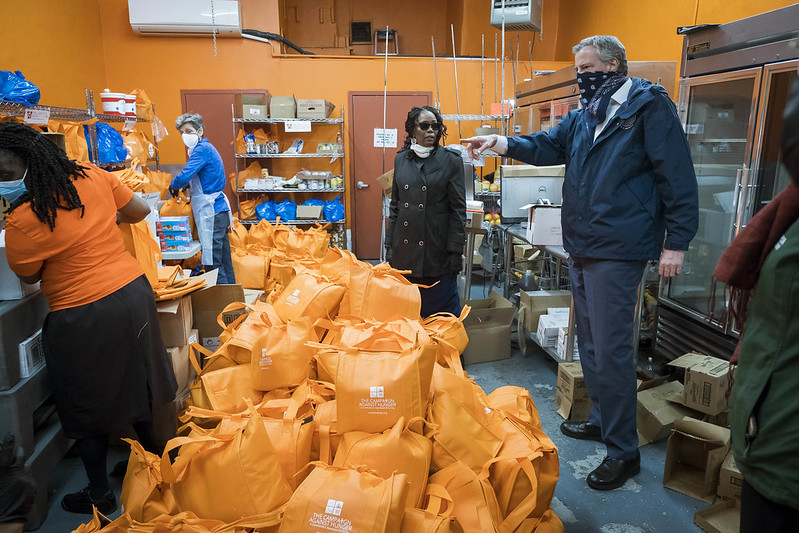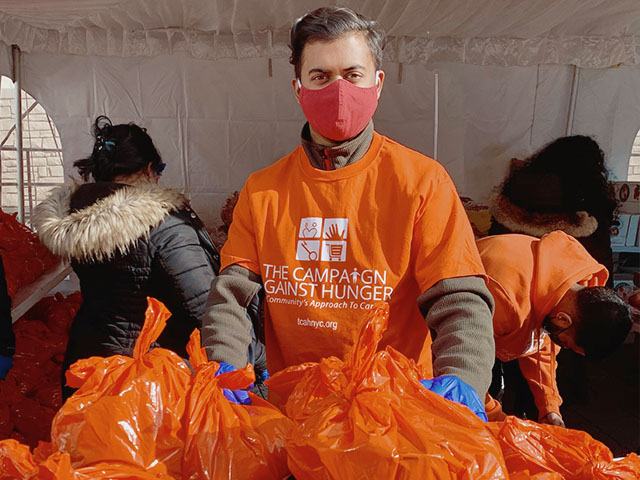‘No New Yorker Goes Hungry’: De Blasio Announces Next Steps to Combat Food Emergency
April 16, 2020 |

As the coronavirus crisis was unfolding in New York City last month, Mayor Bill de Blasio named his sanitation commissioner, Kathryn Garcia, as the new “food czar” to lead the implementation of a massive effort to ensure New Yorkers don’t go hungry. With the city already home to over a million “food insecure” people, the scale of the need accelerated quickly as hundreds of thousands of New Yorkers lost their jobs, school buildings closed, and food pantries struggled to stay open.
The city announced over 400 sites where families with children could pick up food each weekday, then expanded that offering to adults without children, allocated millions of dollars in emergency food bank funding, began coordinating delivery of meals to seniors, and took other initial steps.
According to experts on hunger and food insecurity, one of the major challenges New York City faces amid the current crisis is identifying the population that needs assistance because of the rapidly evolving situation in the city. The city appears to be taking sweeping measures to try to ensure everyone who needs food gets it.
On Tuesday, de Blasio visited the Campaign Against Hunger food pantry in Bedford-Stuyvesant to thank workers there and highlight the importance of emergency food, then dedicated the bulk of his Wednesday coronavirus briefing to the city’s new anti-hunger plans.
“Today I am announcing a $170 million initative to make sure every New Yorker gets what they need and no New Yorker goes hungry,” de Blasio said from City Hall on Wednesday morning, announcing that over the last month the city had provided over 4.5 million free meals. “Thank god we have a strong foundation to build on. All those food pantries and soup kitchens, all the amazing organizations out there that have been doing work all over the city for years and years.”
Called Feeding New York, the plan includes four main planks: First, scaling up and adjusting existing food delivery systems through the Department of Education and Department for the Aging, working with the Office of Emergency Management and under Garcia’s leadership, along with other partners. Second, hiring drivers licensed by the Taxi and Limousine Commission to deliver meals, yielding 11,000 individuals already to both bring needy people meals and provide earnings to drivers who are hurting.
Third, securing the supply by using $50 million to invest in a food reserve that will hold 18 million meals in case of a disruption in the food supply chain. And fourth, protect grocery store workers by telling stores they should “require customers to wear face mask coverings to protect employees and customers” and ask any non-compliant customers to leave. The city is also coordinating with vendors to ensure non-medical personal protective equipment can be accessed by grocery stores, and that the stores can directly place orders for equipment.
“Now, I was in Bed-Stuy, Brooklyn, but this challenge is literally in every neighborhood, because if you have no money, how do you get food?,” de Blasio said on Wednesday. “And we know that the massive unemployment that we’re experiencing is literally every zip code, every part of the city. So, whoever you are, wherever you are, if you need food, we’re here for you, and there should be no shame. I want to emphasize this. It’s no one’s fault that we’re dealing with this horrible crisis. Anyone needs food – we’re here for you. You don’t have to think twice. Of course, it’s for free. Just pick up the phone or go online. And if you need information, you can go to nyc.gov/getfood. You can call 311. You can find all the places, all the ways we’ll get you food. Please do not hesitate and spread the word to everyone you know.”
The mayor estimated that the city will have served about 10 million free meals in the month when April ends, and that May could rise to 15 million meals.
De Blasio’s announcement also comes on the heels of dire warnings from food banks in New York City and across the nation, and announcements from both the state and city governments of $25 million each to help food banks acquire food and pay personnel as the largerly volunteer-run nonprofits struggle to staff their operations. In her role as food czar Garcia is also working with those nonprofits, as well as entities at all levels of government, private companies, and various city agencies.
“The real focus is on both the supply side and also on operations to make sure we are getting food to our most vulnerable,” Garcia said on WNYC’s The Brian Lehrer Show last week. “Some who were vulnerable before and some who have become vulnerable because of the epidemic.” The city is striving to make sure the pandemic “doesn’t become a tragedy about hunger,” she said.
“Despite this crisis, we will not let any New Yorker go hungry, ” de Blasio said last week after visiting a school meal hub at P.S. 1 in Manhattan. “With more New Yorkers asking where their next meal will come from, our 435 Meal Hubs are here to serve them. And none of this would be possible without the hard work of the meal service workers on the front lines. We cannot thank them enough for their service.”
While this is not the first time that New Yorkers have experienced times of crisis leading to food insecurities across the city, it may be the worst or among the worst in modern times given the massive job loss and lag in income so many are facing, even as the federal government has passed a stimulus to send people checks and the state is working through a backlog of unemployment insurance claims. There’s a tremendous amount for Garcia and others to figure out, though the city’s approach appears to be to cast as wide a net as possible and not require anyone to justify a need for food.
“Our biggest challenge, which is very different from what we saw, for example, in [Hurricane] Sandy, is that we don’t have a population that’s already identified that needs assistance, right? The population keeps growing,” said Grace Bonilla, administrator of the city’s Human Resources Administration (HRA), during an online panel discussion convened at the end of March by The Hunter College NYC Food Policy Center. “The rate of growth from neighborhood to neighborhood is different. And I’m speaking for an agency that has to operationalize food, making sure that we’re meeting the needs of so many people as they’re losing their jobs. Then that also is a moving target.”
Kate MacKenzie, the director for the Mayor’s Office of Food Policy, agreed, explaining that delivering services to New Yorkers becomes hard when you have to continuously reevaluate the same problems when populations grow or change.
“The fluid state of everything, right? Of the number of people that we need to feed, of the trucks on the road. Everything changes by the hour. So trying to solve for something that the next day needs to be solved for again,” MacKenzie said.
With school buildings closed to teachers and students, and many children relying on schools for multiple meals a day, it was a natural move for the city to turn schools into the 435 meal hubs across the five boroughs, which are open on weekdays. A spokesperson for the mayor said that individuals and families can collect enough food for the weekends on Fridays.
As city government takes a more active approach to managing the exacerbated hunger crisis — a crisis that was immense even before coronavirus decimated the local economy — the city’s food pantries, soup kitchens, and other such places where food insecure people can get food have also kicked into another gear, but they are struggling to stay open and secure and provide enough food.
There has been huge demand on the food pantry system with this coronavirus pandemic. According to a City Council press release from the end of March, 32% of food pantries and soup kitchens had quickly shut down, with more expected to follow, thus leading to the push for the $25 million in emergency aid that was announced soon after.
Joel Berg, CEO of Hunger Free America, said on the Max & Murphy podcast that “they are having trouble operating. It is important to note how ill-equipped they were to deal with the hunger problem even when times were good. As wonderful as these agencies are — they’re run by the best people I’ve ever met in my life, most of them are volunteers — even in good times, less than one-tenth of the dollar amount of food that the federal nutrition assistance programs provide, and if you include all the federal programs, probably less than one-twentieth of the food that SNAP, what used to be called the food stamp program, the school meals, or the women, infants, and children’s program provides.”
Meanwhile, the recent federal stimulus package will provide New York with $38 million for Emergency Food Assistance Program (TEFAP) Commodities, nearly $16 million for TEFAP Administration, and a little under $35 million for The Special Supplemental Nutrition Program for Women, Infants, and Children (WIC), according to Derek Thomas of FPWA.
Before the emergency city and state funding was announced, the City Council called for the $50 million, $25 million from the state and $25 million from the city, to help food pantry and food assistance programs remain open through the crisis.
“According to Met Council, the combined $50 million will provide funding for over 19 million meals, which will allow for 2.1 million balanced and healthy food packages each consisting of nine meals per USDA guidelines,” a press release said, also noting that more money would be needed after the $50 million.
The money was approved soon after. De Blasio was then asked about it at an April 11 briefing, and said that while it will help, he believes the food situation will get worse before it gets better, and that improving access to food for New Yorkers will be increasingly important.
“I’m not confident yet that everything that is going to be needed is in place. That’s why I named a food czar, Kathryn Garcia, and that’s why I’ve said to her, whatever it’s going to take, we’re going to put forward the resources to make sure that everyone has food. We literally have to have a simple standard,” de Blasio said. “No New Yorker goes without food and what the folks in the Department Education are doing, which is amazing, 435 sites that have now been up over the last week or more where anybody, any adult can come in and get breakfast, lunch and dinner, grab and go as for as many family members as possible. That to me is the kind of thing we’re going to have to do on a really big scale going forward to make sure that everyone has food.”
That line of thinking led to Wednesday’s announcement of the additional efforts in the new Feeding New York plan.
On WNYC, Garcia stressed the challenges with the volunteer base at typical nonprofit emergency food providers, in response to a caller question. “We think it’s absolutely critical to support this particular network,” she said. “This is where we are seeing the most challenges with being able to staff things, with many people being ill or sheltering.” Seniors often volunteer at soup kitchens and food pantries, and also happen to be the most vulnerable population to the novel coronavirus.
“We do have standardized guidance for people, our volunteers, who are wanting to do some home deliveries, who are working in kitchens or pantries or any volunteer capacity for that matter,” MacKenzie said during the Hunter discussion. “Volunteerism is an essential function, but it’s also trying to reconcile that with social isolation. Practices and protocols. So that is something to be mindful of. I think particularly, this is the marathon, this isn’t a sprint here. And whether it’s this week or in June, there’s going to be opportunities for people to plug into a way that makes sense for them.”
City Hall is now making an effort, as part of the Feeding New York plan, to deploy city staff to 14 food pantries across the city that are short on volunteers and are recruiting more through NYC Service, Garcia said at Wednesday’s briefing with the mayor.
Berg mentioned remote opportunities for people to get involved. At his own organization, there are opportunities to work the phones, calling grocery stores and other important entities, and working on the national hunger hotline.
Still, Berg stressed the importance of the larger, government-backed programs that help people secure food, with the nonprofit network playing a key supporting role.
“There are 800 to 1,000 of these agencies and while that sounds like a lot, there are 8,000 retail establishments that accept SNAP,” Berg said on Max & Murphy. “Most of these agencies, in good times, were only open maybe once or twice a month or sometimes once a week or a few hours a day. It’s no shock that a volunteer-run system with many of these people running these programs who are senior citizens, that a fair amount of them have been forced to close down.”
Other organizations are also trying to fill the gap and feed more New Yorkers. On April 8, de Blasio announced that New York Road Runners will donate $100,000 to the Mayor’s Fund to Advance New York City to provide 10,000 meals to frontline healthcare workers.
Bloomberg Philanthropies, established by former Mayor Michael Bloomberg, has donated $6 million to World Central Kitchen specifically for meals for health care workers in public hospitals. De Blasio praised his predecessor for that gift during Wednesday’s briefing.
The benefits programs run by HRA that help New Yorkers access food are becoming increasingly important as people lose their jobs amidst this crisis. Bonilla said that HRA has worked hard to move its services online while retaining the ability to process applications.
“Normally, on any given day we would get 6,000 applications [for assistance],” Bonilla said. “We’ve got about 16,000 in one day. That was at the beginning of the crisis, and we are trying to make sure our folks are working from home so that we can keep them safe, but that they are also able to process the unprecedented number of applications we are getting.”
Garcia explained that New York State has put in an application for Pandemic Supplemental Nutrition Assistance Program (PSNAP), which is pending with USDA. Another program the New York congressional delegation has been advocating for is Disaster Supplemental Nutrition Assistance Program (DSNAP), which relies on a federal disaster declaration.
As the city moves into a second month of extreme social distancing and stay-at-home orders, vulnerable populations, especially seniors, must be at the forefront of the operations, officials and advocates alike have said.
But with the closure of senior centers and the move to expanded food delivery, some seniors have not been getting the food they rely on.
“Now there’s a different initiative for those, for the senior citizens who need help for folks who are homebound, for folks who are vulnerable and that the only solution for them is a delivery. There’s also a growing delivery system,” de Blasio said at his briefing on April 7. “This is something Lorraine Cortés-Vázquez [the Department for the Aging Commissioner] has been working on from the beginning and it’s building all the time. So, anybody who truly needs a home delivery can call 3-1-1 and we’ll get them that delivery. Or they can go to nyc.gov/getfood to sign up.”
As part of the new $170 million plan, Garcia explained that the city is going to register entire buildings of seniors run by NYCHA, city agencies, and nonprofits. In addition, case workers can directly enroll New Yorkers into the free meal delivery system.
[New Yorkers can find the nearest meal hub or food pantry here, find more information on food access here; or text NYC FOOD or NYC COMIDA to 877-877]
***
by Katie Kirker, Gotham Gazette





